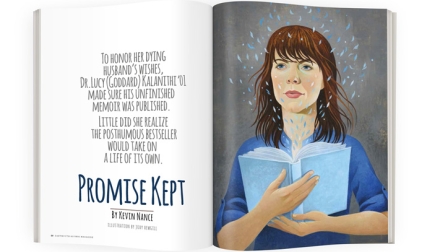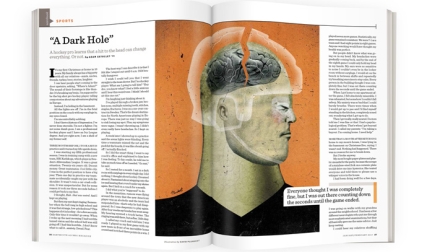Recently Dr. Robert S.D. Higgins gave the plenary address at a conference on diversity in higher education. As one of the most prominent African-American physician leaders in the United States—now surgeon-in-chief at the Johns Hopkins hospitals and director of surgery at Hopkins’ medical school—Higgins is frequently asked to speak about his journey to achieve the many firsts that have distinguished his career.
It’s not an entirely comfortable role for the 57-year-old heart-and-lung transplant surgeon, although achieving distinction as an African-American doctor is certainly important to him. He is quick to point out that—in contrast to 14 percent of the population—African Americans constitute just 4 percent of his profession. Higgins hopes his success is seen as encouraging and his leadership as a door opener, but his ambitions go beyond racial equity. He wants that door open to anyone with ability and accomplishment, regardless of race, gender, ethnicity or other characteristics that have nothing to do with human potential. To make this point, whether from a lectern, as he did at the diversity conference, or in conversation, Higgins offers up lessons from his own life—ones of hardship but also of privilege. He delivers a “count your blessings” homily with a serious, almost stern point: Everyone’s life comes with hurdles, but “they can and must be navigated” to achieve excellence.
Higgins’ career is studded with milestones of accomplishment, many of them carrying the label of “first African American.” He is Hopkins’ first African-American surgeon-in-chief, only the eighth person to hold the post since the preeminent medical school was founded in 1893. He was also the first to hold these positions at Ohio State University (OSU) and, well before that, he was the first African-American battalion major at Albany (New York) Academy, a private boys military school now part of the Albany Academies, where Higgins attended grades K through 12. None of this surprises the people who knew him as a youngster or at Dartmouth or just about any place he’s been.
Ernest D. Steck, 93, a retired teacher and director of athletics at the academy, retains a vivid memory of the faculty meeting that resulted in Higgins’ appointment as battalion major his senior year, putting him in charge of all the drill companies of boys in grades seven through 12. “We would rate the nominated students and then discuss who should be battalion major. But the year Bobby Higgins was nominated, there was no discussion because there was no question he was everyone’s choice. In all the 40 years I was at that school, he stands out as the most extraordinary natural leader, someone who could get along with everyone but also lead without intimidation.”
Higgins was also a high school All-American football player before joining the Dartmouth program, where he played on special teams until he was sidelined by a knee injury. It was the first of three ligament tears that today account for a somewhat rolling gait, though the stockily built Higgins still looks fit enough to put on pads. While recuperating, he got a job managing the Dartmouth hockey team and became friends with Bob Gaudet ’81, then a player and now Dartmouth’s men’s hockey coach.
“We were great friends and also awful to each other,” Gaudet recalls. “A bunch of us used to play doubles tennis and Higgy had that brace on his leg so we kept making drop shots to make him run. He was a lot of fun but there was also a calmness and humility about him and an ability to assess things and make a decision. He was someone you could count on for good advice, the good and the bad news, without sugarcoating it.”
Higgins shares Gaudet’s appreciation for friendships forged at Dartmouth. A member of Theta Delta Chi, he recalls his years in Hanover as “a great time” accompanied by “average grades”—until his mother reminded him of the privilege of higher education and threatened to yank him home if he didn’t get serious. Higgins ratcheted up his performance sufficiently to be accepted to Yale School of Medicine.
“When you take the heart out of an Igloo cooler and remove it from the ice, it is a lifeless, inanimate muscle,” says Higgins. “But once it is implanted and reperfused with life’s blood, it starts beating spontaneously, whoosh, whoosh, whoosh. I get goose bumps every time.”
The decision to become a doctor, Higgins says, had a lot to do with the legacy of his father, also a physician, who was killed in a car accident when Higgins was 5. At the time of the accident (the other driver ran a stop sign) Robert Higgins Sr. had just opened a general practice in his hometown of Charleston, South Carolina, after completing military service with the Navy. “I was a closet premed all through Dartmouth,” Higgins says, still not sure why he kept that goal to himself. “I think I had this feeling of unfinished family business. My father was a bright and dedicated physician who never had a chance to contribute in the way he wanted to.”
Although it wasn’t easy growing up without a father, Higgins is quick to note that the hardships he spoke of at the diversity conference were mostly his mother’s. The determination Patricia Higgins demonstrated in overcoming the loss of her husband so early in their life together, sometimes working two jobs to provide the best for her three sons, continues to inspire her eldest—as does her credo of personal discipline, academic excellence and service to community above self, he says.
“Their mother was remarkable. She had courage,” recalls David Ball, a retired bishop of Albany’s Episcopal Cathedral of All Saints. Ball got to know Patricia when she moved back to her hometown to be close to her parents. A friend of her father’s with no family of his own, he took her sons to and from school and attended their football games. “Bobby has that courage, too. He doesn’t back away from problems,” Ball says.
Higgins’ medical education was rigorous: After Yale medical school came eight years of training in cardiothoracic surgery and organ transplantation. The latter included a stint as senior registrar at Britain’s renowned Papworth Hospital, where Higgins mastered the hardest of transplant specialties: heart and lung. Skilled as he is, Higgins still uses the word “miracle” to describe a successful heart transplant. “When you take the heart out of an Igloo cooler and remove it from the ice, it is a lifeless, inanimate muscle,” he says. “But once it is implanted and reperfused with life’s blood, it starts beating spontaneously, whoosh, whoosh, whoosh. I get goose bumps every time.”
Higgins’ first job after he completed training was as surgical director of the thoracic organ transplantation program at Henry Ford Hospital in Detroit. From there he held chief cardiothoracic surgery posts at the Medical College of Virginia in Richmond and, next, Rush University Medical Center in Chicago, before moving in 2010 to OSU, where he was surgeon-in-chief and director of the Wexner Medical Center Comprehensive Transplant Center. Yet again, he was the first African American to hold these positions.
Along the way Higgins earned a master’s in health services administration from Virginia Commonwealth University. “I wanted to study how to make heavily matrixed places work better,” Higgins says. “I believe doctors should be part of the healthcare leadership, but to do well I felt I needed to learn administration and finance.” Somehow Higgins also found time to serve as president of the United Network for Organ Sharing (the nonprofit group that manages the distribution of organs for transplant in the United States), the Society of Black Academic Surgeons and the Association of Black Cardiovascular and Thoracic Surgeons, and he has authored or coauthored more than 100 scientific papers and book chapters. His research interests include mechanisms of cell injury in failing hearts and racial disparities in post-transplant surgical outcomes.
“I’ve never wanted my career to be a checklist, but when Johns Hopkins offered me this opportunity, I thought I should take it,” says Higgins, who assumed his current post July 1, 2015. “In my mind, it’s incidental that I’m African American because for me, performance is what counts. Hopkins’ bar is high, so performance here has to be about excellence. By that, I don’t mean me, me, me. It’s the department of surgery, the transplant program. My job is to build a team that surpasses expectations on all metrics: clinical, academic and fiscal.”
Whenever Higgins talks about achieving excellence, the word “team” is front and center. As a surgeon, he knows that success depends upon everyone in the operating room working in precise synchrony on behalf of the patient. Not so different from football, nor, in his experience, family.
“I’m standing on the shoulders of a lot of people who have helped me along the way,” says Higgins, who, in turn, is motivated to boost others—especially those historically bypassed by medicine’s hierarchy and elite institutions. One such beneficiary of Higgins’ pay-it-forward philosophy is Ahmet Kilic, now director of the heart transplant program at Ohio State. Kilic, who came to the United States from Turkey at the age of 9, was a medical student when he first met Higgins. Ten years later Higgins hired him as a surgeon on OSU’s transplant service. “He’s been an exemplary role model and I aspire to be the kind of leader he was for me,” says Kilic, 40. “He has a way of including and encouraging people to speak their mind. He may not agree with everything, but by the end of the day he’s worked out a compromise that respects everyone’s contribution and allows people to feel proud of what we accomplished as a team.”
Higgins recalls the support he’s had from his own teams—the many people who rallied around his mother after his father’s death—and most importantly, the support he’s had from his family. He especially appreciates the sacrifices his wife of 26 years, Molly Curran Higgins, has made for his career. The couple met at the University Hospital of Pittsburgh, where Molly was an accomplished intensive care nurse and Higgins was a raw surgical trainee. “I persisted in asking her out even though she didn’t want to go out with a doctor because she didn’t want to play second fiddle to a career—go figure now,” he says. Bishop Ball officiated at their wedding in 1990 and the couple embarked on a nomadic life together, with Molly packing up households and children to accompany her husband to each career stop—until their decision to set down roots in Chicago. Molly is still there with son Grant, 17, so he can finish high school.
Higgins’ choice of transplant surgery complicated things further. When an organ becomes available for a desperately ill patient, nothing on the kitchen calendar—sports games, school events, dinner parties—stands a chance. Indeed, Higgins was in the middle of a heart transplant 21 years ago when Molly went into labor with their daughter, Grace. He managed to finish just in time to sprint to the labor and delivery floor and be at his wife’s side for the birth. (In addition to Grace and Grant, the couple has an older son, John ’14, now in medical school.)
Higgins commutes to be with Molly and Grant in Chicago on weekends and looks forward to the day she, whom he calls his “rock,” can join him in Baltimore. A side table crowded with family photos in Higgins’ office at Hopkins testifies to the importance of the time they’ve been able to share together.
“We need more diversity in medicine to do a better job by our patients, but it has to be a meritocracy. Otherwise it’s just tokenism.”
Hopkins is unusual in that it accepted women from its founding year—a condition set by the school’s benefactor, Mary Elizabeth Garrett. Today medical school classes at Hopkins, as elsewhere in the United States, have equal numbers of men and women, but racial, ethnic and socio-economic diversity still lags, contributing to gaps in scientific knowledge and clinical quality, says Higgins. “We need more diversity in medicine to do a better job by our patients, but it has to be a meritocracy. Otherwise it’s just tokenism,” he adds.
Higgins is not alone in this view. Indeed, the necessity of doing a better job by patients from diverse backgrounds is a financial imperative due to penalties built into the Affordable Care Act for quality failures by healthcare institutions, such as postoperative infections or preventable hospital readmissions. In this context, the need for better knowledge about specific groups of patients—lifestyles, cultural habits, diet, living conditions—is lost on no one in medicine's leadership today. “The whole issue of diversity and inclusion is one we are taking very seriously,” says Ronald R. Peterson, president of Johns Hopkins Health System, which, in addition to the flagship hospital in Baltimore, includes five other hospitals. “There’s much to be said in favor of a clinical workforce that is more like the people we serve, but we need diversity in leadership as well. Dr. Higgins was very attractive to us because in addition to his accomplishments as a surgeon he’s comfortable dealing up and down the chain of command and knows how to motivate and pull people together. These are complex management positions and leadership ability is paramount.”
Higgins’ responsibilities have left him with less time in the operating room—and he misses that. But he also relishes the challenge of building the field of transplant medicine and sharing his knowledge—and the “miracles” he’s witnessed—with the next generation of surgeons.
A reminder of one such miracle arrived in the mail as the Higgins family was planning Grace’s 21st birthday celebration. It was a card addressed to Higgins from that long-ago heart transplant patient who almost caused Higgins to miss his daughter’s birth. “He wanted to thank me for 21 extra years of life—imagine that! And then at the end, he wrote: ‘By the way, tell your daughter happy birthday.’ ”
Irene M. Wielawski is a freelance journalist specializing in healthcare topics. A frequent contributor to DAM, she lives in Pound Ridge, New York.




